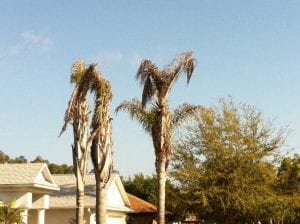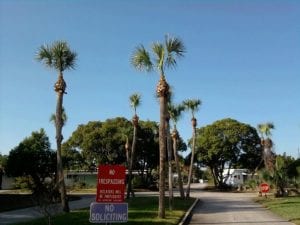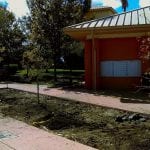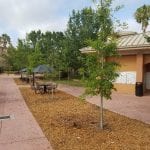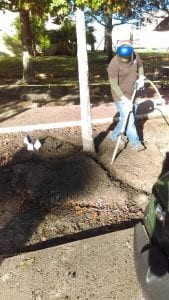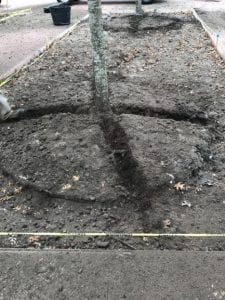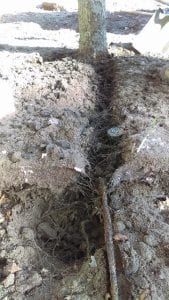What’s Wrong with My Palm?
By Ray Jarrett, Coordinator, Urban Forestry and Land Management
ISA Certified Arborist (FL-5343A)
Palms are a natural and iconic component of Florida’s natural and planted landscape. They symbolize the tropics and provide aesthetic beauty for homeowners. Palms come in all sizes and shapes from low groundcovers to towering canopy trees. Florida has eleven (11) palms that are native to the state including needle palm, saw palmetto, royal palm and the state tree, the sabal palm. These palms grow in a variety of habitats and often make great additions to landscapes. Additionally, there are dozens of non-native palms used in Florida landscaping including Washingtonian, queen, ribbon, and pindo palms. All of these palms have different care, watering and nutrient needs. Managing palms in the landscape can be challenging. There are several diseases and nutritional disorders that affect palms. One of the most recent diseases, that has been affecting queen palms and Washingtonian palms, is Fusarium Wilt. This disease is only known to infect these two species of palms and their cultivars and is always fatal. This disease is spread by wind, animals and by improper pruning and sanitation. Some palms to consider as replacements for infected Washingtonian and queen palms include sabal, Puerto Rican hat, triangle, Carnaday and ribbon palms. These varieties can be found at palm nurseries such as Fishbranch Tree Farm, https://www.fishbranchtreefarm.com/ .
Palms are often harshly pruned annually or ‘hurricane cut’ for aesthetics and maintenance. This is a bad practice and not needed for palm care. Harsh pruning of palms can lead to nutritional disorders like boron deficiency or manganese deficiency commonly known as ‘Frizzle top’.
Additionally, harsh pruning causes palms to grow taller and faster than normal, develop bottleneck trunks and makes them susceptible to insect pests like palm weevils. There are several other diseases than can affect palms including Ganoderma rot, lethal yellowing and bud rot of palms. Many of these diseases can be mitigated by ensuring palms are properly pruned and fertilized with an appropriate formulation designed for palms. These diseases, nutritional disorders and other information about palm care can be found at the University of Florida (UF), Institute of Food and Agricultural Sciences (IFAS) palm website, http://edis.ifas.ufl.edu/topic_palm_diseases . The following bullet points are some Best Management Practices (BMP’s) to consider when managing palms in your landscape:
- Contact an International Society of Arboriculture (ISA) Certified Arborist to have your palms reviewed for maintenance recommendations, fertilization and overall care.
- Avoid harsh pruning or ‘hurricane cutting’ palm trees. Harsh pruning of palms can lead to nutritional disorders, insect pests and other diseases.
- Prune only dead fronds and old fruiting branches of palms. Avoid pruning green fronds when possible. When green fronds are pruned, these pruning cuts leave open wounds that can allow fungal diseases to infect the palm.
- It is better for the long term health of palms for pruning to be done from the ground or with aerial equipment. Refrain from allowing pruners to use spikes to climb the trunks, unless it is absolutely necessary, as this can be a way for diseases to be spread from tree to tree.
- Ensure that palm pruning is done with hand tools that are sanitized in between each individual palm as recommended by UF/ IFAS. Chainsaws are much more difficult to sanitize in between palms, so be sure your pruner uses an effective method.
- Fertilize palms using an 8-2-12, + 4% magnesium palm fertilizer. This formulation was researched by UF / IFAS and is recommended for use in Florida.
Extreme pruning puts Florida palm trees in peril
Click here for the USA Today article
Air Spading at UCF’s Academic Village
Posted June 2017
Air spading is a soil aeration and excavation process that enables tree care professionals to treat problems associated with compressed soils, girdling roots, and nutrient deficiencies. The air spading tool looks similar to a pressure washer, but instead of emitting water it emits highly compressed air, which is minimally damaging to tree roots. The compressed air blows away soil at the base of the tree and around tree roots to either aerate the soils, expose girdling roots, or to create holes in the ground where nutrients can be directly injected. It can also be used to expose roots prior to construction or repair activities to examine location and size of roots before excavating the soil.
The LNR Urban Forestry team recently used air spading to address problem conditions for trees growing in the in the Nike and Hercules housing community courtyard area. The picture below shows three small Nuttall Oaks in that area that were planted in 2006. The other larger trees in the distance were planted at the same time as the smaller trees but were not exposed to excessive root compaction, and thus they were able to develop better root systems, take up more nutrients, and grow larger and healthier than the smaller restricted trees. On January 11th, 2017 the UCF Urban Forestry team conducted air spading on all the Nuttall Oaks in this area affected by excessive soil compaction. The team used a method known as radial trenching. They used the air spade to create four radialtrenches extending like spokes on a wheel from the center of each tree. These trenches were filled with loosely packed, organic soil, which will help reinvigorate the tree, enhance nutrient uptake, and allow the roots to develop more efficiently. The planters will not be filled with concrete again, but will be planted with a Florida friendly landscape that will help retain water and produce a better environment root growth and enhanced nutrient uptake by the trees.

